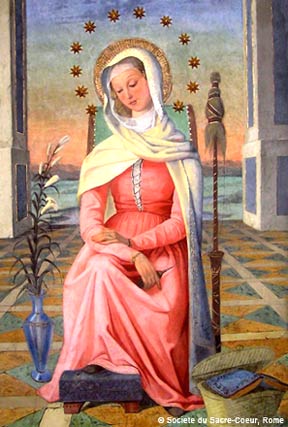Mater Admirabilis was painted in 1844 by Pauline Perdrau, who at that time was a Sacred Heart postulant. Her feast is celebrated on the 20th October, a special day for Religious of the Sacred Heart, their co-workers and friends throughout the world.
In the midst of our busy lives may we allow ourselves to be touched by the stillness of this image, asking Mary to show us in her interiour life, the source of her total, true love.
God's mercy and faithfulness shine forth in a world wounded by sin. He has sent His beloved Son who became one of us, and gave up His life, to set us free, to make us a new creation and to gather together all things in Himself for the glory of His Father. (Constitutions, #2)
By our charism, we are consecrated to glorifying the heart of Jesus:
we answer His call to discover and reveal His love letting ourselves be transformed by His Spirit so as to live united and conformed to Him, and through our love and service to radiate the very love of His Heart. (#4)
Mary, woman of faith among the People of God lives close to us, as she does to everything that radiates the life of her Son.
Our Society entrusts itself in a special way to her whose heart is united and conformed to that of Jesus, so that she may lead us to Him. (#9)
Our Society entrusts itself in a special way to her whose heart is united and conformed to that of Jesus, so that she may lead us to Him. (#9)
This contemplative attitude permeates our whole being,
helping us to live ever more united to Christ in our relationships, our tasks and our ministry;
it becomes a powerful force of conversion and transformation for mission.
In welcoming God's word, Mary gave Christ to the world.
In receiving the life of Jesus we give ourselves with Him so that all may have life. (#22)
it becomes a powerful force of conversion and transformation for mission.
In welcoming God's word, Mary gave Christ to the world.
In receiving the life of Jesus we give ourselves with Him so that all may have life. (#22)
“Your little blessed Virgin is not at all bad. On my way to the tribune, I often take a turn to go to look at her. She attracts me because she is the age of our students and speaks to me of the young people to whom I have vowed my life.”
(St. Madeleine Sophie Barat to Pauline Perdrau. Quoted in Leisure Hours at Layrac Abbey.)
“I want to draw your attention to the fidelity of Mary; Mary is a model of a fidelity to which we cannot even come close. In speaking of infidelities, I do not mean faults that the weakness of our nature causes…but those that close our hearts and keep our Lord at a distance; those little voluntary infidelities to which we easily give in: a light that we do not wish to follow, an inspiration that we resist… Fidelity and receptivity to grace. Litany to Mater.”
(St. Madeleine Sophie Barat, Conférences I, p. 31)
Our Spirituality |The Sacred Heart Spiritual Tradition
Tags |Mater Admirabilis



